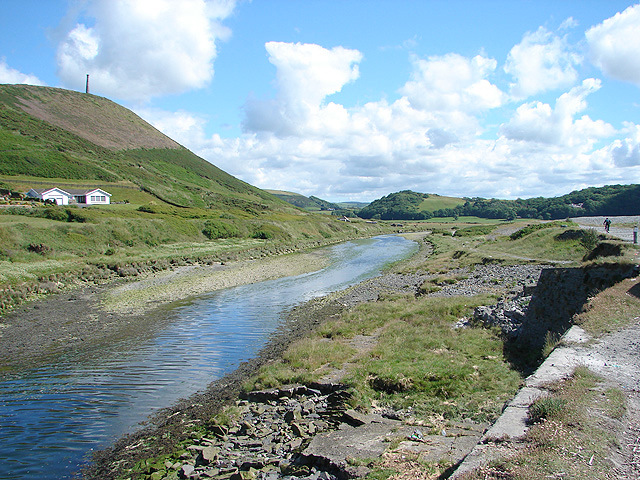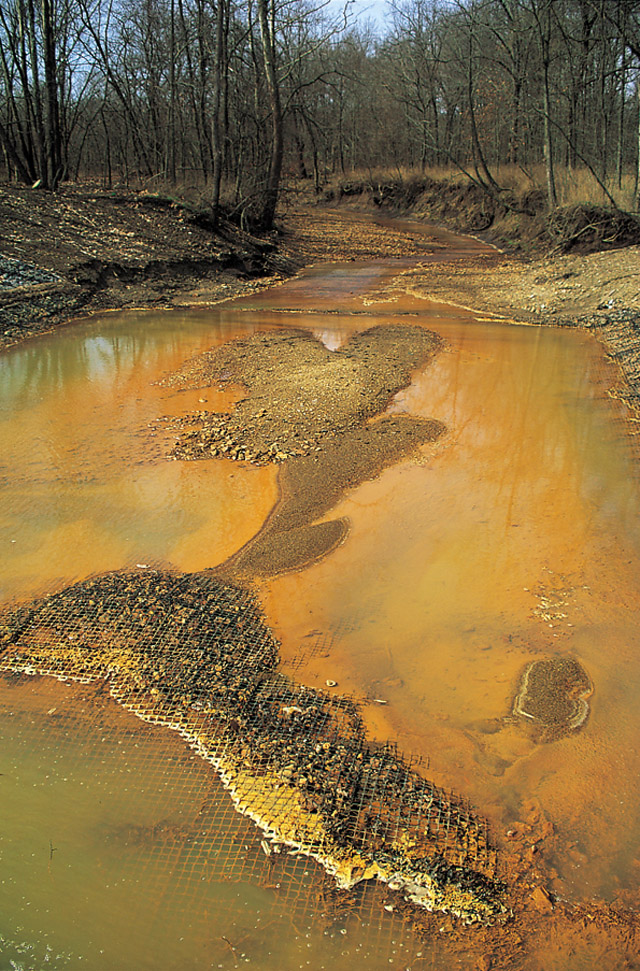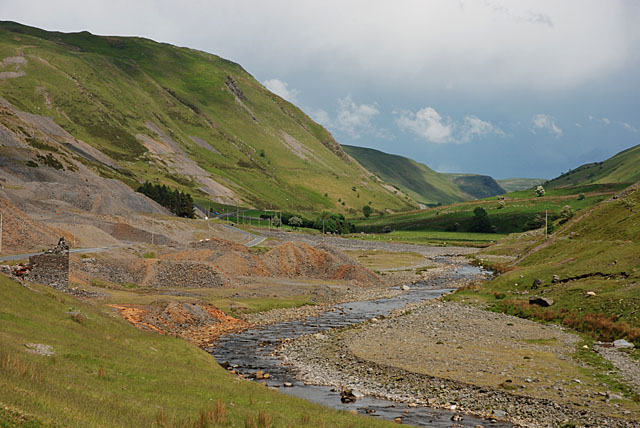|
Ystwyth Valley
The River Ystwyth (; ; ) is a river in Ceredigion, Wales. The length of the main river is . Its catchment area covers . Its source is a number of streams that include the Afon Diliw, located on the west slopes of Plynlimon on the border of Ceredigion and Powys in the Cambrian Mountains. The Ystwyth flows westwards before its confluence with the Afon Rheidol and the estuary at Aberystwyth to drain into Cardigan Bay. The Ystwyth valley is sparsely populated with villages, namely Ysbyty Ystwyth, Cwm Ystwyth, Pont-rhyd-y-groes, Llanilar and Llanfarian. In previous centuries, the valley was relatively densely populated due to its mineral wealth. Silver, lead and zinc have been mined in the valley since Roman times, an activity that reached its peak in the 18th century. The largest of the very many mines was Cwm Ystwyth Mine. It is reputed that the average age at death of the miners in Cwm Ystwyth was 32, largely because of acute lead poisoning. There is no active metal mining in t ... [...More Info...] [...Related Items...] OR: [Wikipedia] [Google] [Baidu] |
Trawsgoed
is a community and an estate in Ceredigion, Wales. The estate is southeast of Aberystwyth, and has been in the possession of the Vaughan family since 1200.Trawsgoed Estate The Vaughans are descended from Collwyn ap Tangno, founder of the fifth noble tribe of North Wales, Lord of Eifionydd, Ardudwy, and part of Llŷn, who had his residence on the site of Harlech Castle. The land falls within the ancient parish of Llanafan, [...More Info...] [...Related Items...] OR: [Wikipedia] [Google] [Baidu] |
Llanilar
Llanilar () is a village and community in Ceredigion, Wales, about southeast of Aberystwyth. It is the eponym of the hundred of Ilar. The population at the 2011 census was 1,085. The community includes Rhos-y-garth. Name In Welsh placenames, many smaller communities are named for their parish ('' llan''), having grown up around the local church. This town's name honours its patron saint, although it is disputed whether that is the church's presumed founder Ilar ( Welsh for " Hilary"), listed as a member of Cadfan's mission and a martyr but now almost totally forgotten, or the more famous Hilary who was bishop of Poitiers in France and is still celebrated by the Anglican and Catholic churches in Wales.Baring-Gould, Sabine & al''The Lives of the British Saints: The Saints of Wales and Cornwall and Such Irish Saints as Have Dedications in Britain'', Vol. III, pp. 299 f Chas. Clark (London), 1908. Hosted at Archive.org. Accessed 25 Nov 2014. (The confusion ... [...More Info...] [...Related Items...] OR: [Wikipedia] [Google] [Baidu] |
Tailings
In mining, tailings or tails are the materials left over after the process of separating the valuable fraction from the uneconomic fraction (gangue) of an ore. Tailings are different from overburden, which is the waste rock or other material that overlies an ore or mineral body and is displaced during mining without being processed. Waste valorization is the evaluation of waste and residues from an economic process in order to determine their value in reuse or recycling, as what was gangue at the time of separation may increase with time or more sophisticated recovery processes. The extraction of minerals from ore can be done two ways: placer mining, which uses water and gravity to concentrate the valuable minerals, or hard rock mining, which pulverizes the rock containing the ore and then relies on chemical reactions to concentrate the sought-after material. In the latter, the extraction of minerals from ore requires comminution, i.e., grinding the ore into fine partic ... [...More Info...] [...Related Items...] OR: [Wikipedia] [Google] [Baidu] |
Kubla Khan
"Kubla Khan: or A Vision in a Dream" () is a poem written by Samuel Taylor Coleridge, completed in 1797 and published in 1816. It is sometimes given the subtitles "A Vision in a Dream" and "A Fragment." According to Coleridge's preface to "Kubla Khan", the poem was composed one night after he experienced an opium-influenced dream after reading a work describing Xanadu, the summer capital of the Mongol-led Yuan dynasty of China founded by Kublai Khan (Emperor Shizu of Yuan). Upon waking, he set about writing lines of poetry that came to him from the dream until he was interrupted by "a person on business from Porlock". The poem could not be completed according to its original 200–300 line plan as the interruption caused him to forget the lines. He left it unpublished and kept it for private readings for his friends until 1816 when, at the prompting of Lord Byron, it was published. The poem is vastly different in style from other poems written by Coleridge. The first stanza ... [...More Info...] [...Related Items...] OR: [Wikipedia] [Google] [Baidu] |
Samuel Taylor Coleridge
Samuel Taylor Coleridge ( ; 21 October 177225 July 1834) was an English poet, literary critic, philosopher, and theologian who was a founder of the Romantic Movement in England and a member of the Lake Poets with his friend William Wordsworth. He also shared volumes and collaborated with Charles Lamb, Robert Southey, and Charles Lloyd (poet), Charles Lloyd. He wrote the poems ''The Rime of the Ancient Mariner'' and "Kubla Khan", as well as the major prose work ''Biographia Literaria''. His critical works were highly influential, especially in relation to William Shakespeare, and he helped introduce German idealist philosophy to English-speaking cultures. Coleridge coined many familiar words and phrases, including "suspension of disbelief". He had a major influence on Ralph Waldo Emerson and American transcendentalism. Throughout his adult life, Coleridge had crippling bouts of anxiety and depression; it has been speculated that he had bipolar disorder, which had not been defin ... [...More Info...] [...Related Items...] OR: [Wikipedia] [Google] [Baidu] |
John Nash (architect)
John Nash (18 January 1752 – 13 May 1835) was an English architect of the Georgian and Regency eras. He was responsible for the design, in the neoclassical and picturesque styles, of many important areas of London. His designs were financed by the Prince Regent and by the era's most successful property developer, James Burton. Nash also collaborated extensively with Burton's son, Decimus Burton. Nash's best-known solo designs are the Royal Pavilion, Brighton; Marble Arch; and Buckingham Palace. His best-known collaboration with James Burton is Regent Street and his best-known collaborations with Decimus Burton are Regent's Park and its terraces and Carlton House Terrace. The majority of his buildings, including those that the Burtons did not contribute to, were built by James Burton's company. Background and early career Nash was born in 1752, probably in Lambeth, south London. His father was a millwright also called John (1714–1772). From 1766 or 1767, Nash ... [...More Info...] [...Related Items...] OR: [Wikipedia] [Google] [Baidu] |
Thomas Johnes
Thomas Johnes FRS (1 September 1748 – 23 April 1816) was a Member of Parliament, landscape architect, farmer, printer, writer and social benefactor. He is best known for his development of the Hafod Estate in Wales. Johnes was born in Ludlow, Shropshire, England. Upon moving from his family home at Croft Castle to an isolated area near Cwmystwyth, in Ceredigion, Wales, Johnes began his life works by building a church for the local tenants, a school, and magnificent gardens, walks and bridges. He undertook experiments in sheep and cattle breeding together with the growing of new crops and a thriving dairy was established. Trees were planted in great quantities on land considered unsuitable for crops; Johnes obtained the Royal Society of Arts medal five times for planting trees. He encouraged his tenants to improve their farming practices when in 1800 he published ''A Cardiganshire Landlord's Advice to his Tenants'', with a Welsh translation and offered prizes for good cr ... [...More Info...] [...Related Items...] OR: [Wikipedia] [Google] [Baidu] |
Hafod Uchtryd
The Hafod estate, also known as , is a wooded and landscaped estate in the Ystwyth valley in Ceredigion, Wales. Near Devil's Bridge, Cwmystwyth and Pont-rhyd-y-groes, it is off the B4574 road. Hafod estate land was within the boundaries of the Cistercian Abbey Strata Florida (). Originally a hunting lodge for Welsh Chieftains, it became home to the landed gentry and the nobility. In the late eighteenth century, a celebrated landscape was created under the ownership of Thomas Johnes. The estate is in the parish of Llanfihangel y Creuddyn near Llanddewi-Brefi. Llanfihangel-y-Creuddyn was a chapel-of-ease in the parish. It was rebuilt for Thomas Johnes by James Wyatt in 1801. The estate shares a border along the Ystwyth with that of the Trawsgoed estate. Early history After the dissolution of the monasteries by king Henry VIII (1536–1540) during the English Reformation the abbey's holdings were divided and awarded to new tenants. Some of the Strata Florida lands were ... [...More Info...] [...Related Items...] OR: [Wikipedia] [Google] [Baidu] |
Lead Poisoning
Lead poisoning, also known as plumbism and saturnism, is a type of metal poisoning caused by lead in the body. Symptoms may include abdominal pain, constipation, headaches, irritability, memory problems, infertility, numbness and paresthesia, tingling in the hands and feet. It causes almost 10% of intellectual disability of otherwise unknown cause and can result in behavioral problems. Some of the effects are permanent. In severe cases, anemia, seizures, coma, or death may occur. Exposure to lead can occur by contaminated air, water, dust, food, or consumer products. Lead poisoning poses a significantly increased risk to children and pets as they are far more likely to ingest lead indirectly by chewing on toys or other objects that are coated in lead paint. Additionally, children absorb greater quantities of lead from ingested sources than adults. Exposure at work is a common cause of lead poisoning in adults with certain occupations at particular risk. Diagnosis is typically b ... [...More Info...] [...Related Items...] OR: [Wikipedia] [Google] [Baidu] |
Cwm Ystwyth Lead Mine
Cwmystwyth mines are located in Cwmystwyth, Ceredigion, Wales and exploited a part of the Central Wales Orefield. Cwm Ystwyth is a scheduled monument, with mining activity dating back to the Bronze Age. Silver, lead, and zinc mining peaked in the 18th century, and water was extensively used in the extraction process. The Banc Ty'nddôl, the earliest gold artifact discovered in Wales, was found on the site in 2002. Mining in the area caused substantial environmental impact; lead concentrations in the River Ystwyth declined from 0.4 mg/L in 1919 to below 0.05 mg/L in 1939, with fish populations returning to most of the river by 1975. Mining heritage Cwm Ystwyth is considered the most important non-ferrous metal mining site in Wales, providing a premier example of mining heritage in Ceredigion. Within the site is evidence for all phases of mining activity; from the Bronze Age, through the medieval period, to its revival in the 18th century and the peak of activity, with a subse ... [...More Info...] [...Related Items...] OR: [Wikipedia] [Google] [Baidu] |
Roman Britain
Roman Britain was the territory that became the Roman province of ''Britannia'' after the Roman conquest of Britain, consisting of a large part of the island of Great Britain. The occupation lasted from AD 43 to AD 410. Julius Caesar invaded Britain in 55 and 54 BC as part of his Gallic Wars. According to Caesar, the Britons had been overrun or culturally assimilated by the Belgae during the British Iron Age and had been aiding Caesar's enemies. The Belgae were the only Celtic tribe to cross the sea into Britain, for to all other Celtic tribes this land was unknown. He received tribute, installed the friendly king Mandubracius over the Trinovantes, and returned to Gaul. Planned invasions under Augustus were called off in 34, 27, and 25 BC. In 40 AD, Caligula assembled 200,000 men at the Channel on the continent, only to have them gather seashells () according to Suetonius, perhaps as a symbolic gesture to proclaim Caligula's victory over th ... [...More Info...] [...Related Items...] OR: [Wikipedia] [Google] [Baidu] |
Zinc
Zinc is a chemical element; it has symbol Zn and atomic number 30. It is a slightly brittle metal at room temperature and has a shiny-greyish appearance when oxidation is removed. It is the first element in group 12 (IIB) of the periodic table. In some respects, zinc is chemically similar to magnesium: both elements exhibit only one normal oxidation state (+2), and the Zn2+ and Mg2+ ions are of similar size. Zinc is the 24th most abundant element in Earth's crust and has five stable isotopes. The most common zinc ore is sphalerite (zinc blende), a zinc sulfide mineral. The largest workable lodes are in Australia, Asia, and the United States. Zinc is refined by froth flotation of the ore, roasting, and final extraction using electricity ( electrowinning). Zinc is an essential trace element for humans, animals, plants and for microorganisms and is necessary for prenatal and postnatal development. It is the second most abundant trace metal in humans after iron, an import ... [...More Info...] [...Related Items...] OR: [Wikipedia] [Google] [Baidu] |








